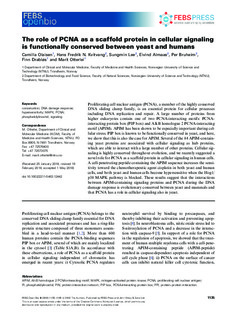| dc.contributor.author | Olaisen, Camilla | |
| dc.contributor.author | Kvitvang, Hans Fredrik Nyvold | |
| dc.contributor.author | Lee, Sungmin | |
| dc.contributor.author | Almaas, Eivind | |
| dc.contributor.author | Bruheim, Per | |
| dc.contributor.author | Drabløs, Finn | |
| dc.contributor.author | Otterlei, Marit | |
| dc.date.accessioned | 2019-03-04T09:38:05Z | |
| dc.date.available | 2019-03-04T09:38:05Z | |
| dc.date.created | 2019-01-14T09:39:25Z | |
| dc.date.issued | 2018 | |
| dc.identifier.citation | FEBS Open Bio. 2018, 8 (7), 1135-1145. | nb_NO |
| dc.identifier.issn | 2211-5463 | |
| dc.identifier.uri | http://hdl.handle.net/11250/2588411 | |
| dc.description.abstract | Proliferating cell nuclear antigen (PCNA), a member of the highly conserved DNA sliding clamp family, is an essential protein for cellular processes including DNA replication and repair. A large number of proteins from higher eukaryotes contain one of two PCNA‐interacting motifs: PCNA‐interacting protein box (PIP box) and AlkB homologue 2 PCNA‐interacting motif (APIM). APIM has been shown to be especially important during cellular stress. PIP box is known to be functionally conserved in yeast, and here, we show that this is also the case for APIM. Several of the 84 APIM‐containing yeast proteins are associated with cellular signaling as hub proteins, which are able to interact with a large number of other proteins. Cellular signaling is highly conserved throughout evolution, and we recently suggested a novel role for PCNA as a scaffold protein in cellular signaling in human cells. A cell‐penetrating peptide containing the APIM sequence increases the sensitivity toward the chemotherapeutic agent cisplatin in both yeast and human cells, and both yeast and human cells become hypersensitive when the Hog1/p38 MAPK pathway is blocked. These results suggest that the interactions between APIM‐containing signaling proteins and PCNA during the DNA damage response is evolutionary conserved between yeast and mammals and that PCNA has a role in cellular signaling also in yeast. | nb_NO |
| dc.language.iso | eng | nb_NO |
| dc.publisher | Wiley Open Access | nb_NO |
| dc.rights | Navngivelse 4.0 Internasjonal | * |
| dc.rights.uri | http://creativecommons.org/licenses/by/4.0/deed.no | * |
| dc.title | The role of PCNA as a scaffold protein in cellular signaling is functionally conserved between yeast and humans | nb_NO |
| dc.type | Journal article | nb_NO |
| dc.type | Peer reviewed | nb_NO |
| dc.description.version | publishedVersion | nb_NO |
| dc.source.pagenumber | 1135-1145 | nb_NO |
| dc.source.volume | 8 | nb_NO |
| dc.source.journal | FEBS Open Bio | nb_NO |
| dc.source.issue | 7 | nb_NO |
| dc.identifier.doi | 10.1002/2211-5463.12442 | |
| dc.identifier.cristin | 1655846 | |
| dc.description.localcode | © 2018 The Authors. Published by FEBS Press and John Wiley & Sons Ltd. This is an open access article under the terms of the Creative Commons Attribution License | nb_NO |
| cristin.unitcode | 194,65,15,0 | |
| cristin.unitcode | 194,66,15,0 | |
| cristin.unitname | Institutt for klinisk og molekylær medisin | |
| cristin.unitname | Institutt for bioteknologi og matvitenskap | |
| cristin.ispublished | true | |
| cristin.fulltext | original | |
| cristin.qualitycode | 1 | |

